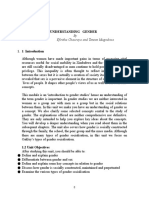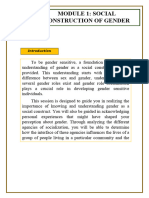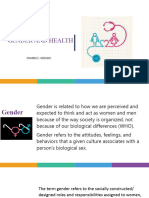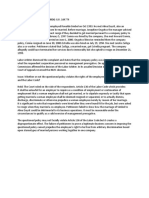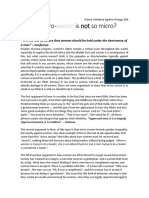University of the Philippines
TACLOBAN COLLEGE
Soc Sci 105: Gender Issues in Philippine Society
First Semester AY 2023-2024
Module 1: Introduction to Sex and Gender
Week 2: Sex and Gender Concepts1
Introduction
This week we will review some basic concepts and terms pertaining to sex and gender.
Learning Outcomes
At the end of this guide, you should be able to:
1. Differentiate between sex and gender, sex roles and gender roles, and gender equality
and equity;
2. Explain how gender stereotypes affect individuals;
3. Discuss how the Magna Carta of Women or RA 9710 protects women from gender
discrimination and promote gender equality
Study Schedule
For this module, you will have a total of 5 face-to-face class discussions and 8 asynchronous
learning activities. The latter will take you approximately 10 hours to complete. Actual number of
hours of completion may vary. Meanwhile, each face-to-face meeting will run for a maximum of
90 minutes.
The table below shows your learning activities for Week 2.
Activity Number Task Allotted Time Mode
Activity 1 Think and reflect 90 minutes Asynchronous
Activity 2 Class discussion 90 minutes Face-to-face (Sep 4)
Activity 3 Think and reflect 60 minutes Asynchronous
1
Prepared by Asst. Prof. Ruth Edisel Rylle Sadian-Cercado
Page 1 of 5
� Activity 4 Class discussion 90 minutes Face-to-face (Sep 7)
Activity 5 Discussion Forum
Now proceed with Activity 1 below and the rest of the module.
Activity 1: Think and reflect
1) Read Eviota’s chapter on Sex, Gender and Society. The material is uploaded in our
course site.
2) Watch this video:
Rappler. (2014, January 22). Where does the Filipino woman stand today? Youtube.
https://www.youtube.com/watch?v=zcw9tGO80Xo
3) After you engage with the materials, reflect on these guide questions:
What is sex? How is it different from gender?
Think of activities that your parents usually assign you to accomplish. Recall some
expectations that your parents or adults around you usually tell you. How did they
affect your attitudes and behaviors as a girl/boy and later a man/woman? Which of
those activities that you needed to accomplish were sex roles? Which were gender
roles?
4) Be ready to share your insights with the class.
Activity 2: Class discussion (90 mins)
1) Be ready to share your insights and questions during our face-to-face session on
September 4, 2023.
Activity 3: Think and reflect (60 minutes)
1) Visit this Gender Decoder for Job Ads. Click the “Check an Ad” tab. Job advertisements
and position descriptions can be pasted into the field provided and it will generate advice
on the language used, i.e. whether the wording is masculine, feminine or gender neutral.
On the homepage, you can see which words are masculine-coded or feminine-coded.
Read through the list and try to reflect which of these words have been ascribed to you
as a woman or man.
2) Watch this video:
TedWomen (2015, May). Why Gender Equality is good for everyone, men included.|
Michael Kimmel| (Video file).
https://www.ted.com/talks/michael_kimmel_why_gender_equality_is_good_for_every
one_men_included?language=en
3) After you engage with the materials, reflect on these guide questions:
What are sex roles? How is it different from gender roles? How did we come about
our gender roles?
What does gender equality mean? How is it different from gender equity?
4) Be ready to share your insights in class.
Activity 4: Class discussion (90 mins)
Page 2 of 5
� 1) Be ready to share your insights and questions during our face-to-face session on
September 7, 2023.
Concluding note
This week, we have delineated the differences between: a) sex and gender; b) sex roles and
gender roles, and b) gender equality and gender equity. Below is a summary of the key points
that you should remember for this week:
Sex refers to biological characteristics (including genetics, anatomy and physiology) that
generally define humans as female or male. Note that these biological characteristics
are not mutually exclusive; there are individuals who possess both male and female
characteristics and they are referred to as intersex.
Gender is a set of socially constructed roles and responsibilities associated with being
girl and boy or women and men, and in some cultures a third or other gender.
At birth, the difference between boys and girls is their sex; as they grow up society gives
them different roles, attributes, opportunities, privileges and rights that in the end create
the social differences between men and women.
The difference between sex and gender is further summarized in the table below:
SEX GENDER
Not born with
Learned
Born with Gender roles vary greatly in different
Natural societies, cultures and historical
periods as well as they also depend
Universal, a historical
on socio-economic factors, age,
No variation from culture to
education, ethnicity and religion.
culture or time to time
Although deeply rooted, gender roles
can be changed over time, since
social values and norms are not static.
Gender roles are the sets of behaviour, roles and responsibilities attributed to women
and men respectively by society which are reinforced at the various levels of the society
through its political and educational institutions and systems, employment patterns,
norms and values, and through the family. Gender roles are culturally regarded as
feminine and masculine. Example: Child rearing and bottle feeding are gender roles of
men.
Sex roles are biological functions belonging to a particular sex category: male and
female. Example: Childbirth and lactating are sex roles of women.
Gender stereotypes are preconceived ideas whereby females and males are arbitrarily
assigned characteristics and roles determined and limited by their gender (European
Institute for Gender Equality).
Gender stereotyping can limit the development of the natural talents and abilities of
girls and boys, women and men, as well as their educational and professional
experiences and life opportunities in general. Stereotypes about women both result from,
and are the cause of, deeply ingrained attitudes, values, norms and prejudices against
Page 3 of 5
� women. They are used to justify and maintain the historical relations of power of men
over women as well as sexist attitudes that hold back the advancement of women.
Gender equality is the state or condition that affords women and men equal enjoyment
of human rights, socially valued goods, opportunities and resources, allowing both sexes
the same opportunities and potential to contribute to, and benefit from, all spheres of
society (economic, political, social, and cultural). Ex. A family has limited funds, and both
daughter and son need a new pair of shoes for the new school year, but only one can
get new shoes this year. If the family decides (and who in the family decides?) which
child will get the new shoes based on the child’s NEED, and not on the child’s sex, this is
an example of gender equality.
Gender equity is justice and fairness in the treatment of women and men in order to
eventually achieve gender equality, often requesting differential treatment of women and
men (or specific measures) in order to compensate for the historical and social
disadvantages that prevent women and men from sharing a level playing field. Ex.
Provision of leadership training for women or establishing quotas for women in decision-
making positions in order to achieve the state of gender equality.
Equity leads to equality! Equity means that there is a need to continue taking differential
actions to address historical inequality among men and women and achieve gender
equality. In the Philippines we have enacted the Magna Carta of Women or RA 9710, a
law that seeks to eliminate discrimination against women by recognizing, protecting,
fulfilling and promoting the rights of Filipino women, especially those in marginalized
sectors. You may read more about the Magna Carta of Women here.
Learning resources
Eviota, E.U. (1992). Sex, Gender, and Society. In Political Economy of Gender: Women and
Sexual Division of Labor in the Philippines. pp. 3-10. Zed Books. (may be downloaded
from the course site)
Barlow, R. (2014, January 16). BU Research: A riddle reveals depth of gender bias.
https://www.bu.edu/articles/2014/bu-research-riddle-reveals-the-depth-of-genderbias
Gender Decoder. http://gender-decoder.katmatfield.com/about
European Institute for Gender Equality, (n.d.). Gender stereotypes.
https://eige.europa.eu/thesaurus/terms/1222
International Federation of Red Cross and Red Crescent Societies. (2003). Sex vs. Gender
statements about men and women.
PSA. (2010, March 15). Q & A Magna Carta of Women (Republic Act 9710).
https://psa.gov.ph/content/q-magna-carta-women-republic-act-no-9710
Rappler. (2014, January 22). Where does the filipino woman stand today? Youtube.
https://www.youtube.com/watch?v=zcw9tGO80Xo
TedWomen (2015, May). Why Gender Equality is good for everyone, men included.|Michael
Kimmel| (Video file).
Page 4 of 5
�https://www.ted.com/talks/michael_kimmel_why_gender_equality_is_good_for_everyone_
men_included?language=en
Page 5 of 5
















